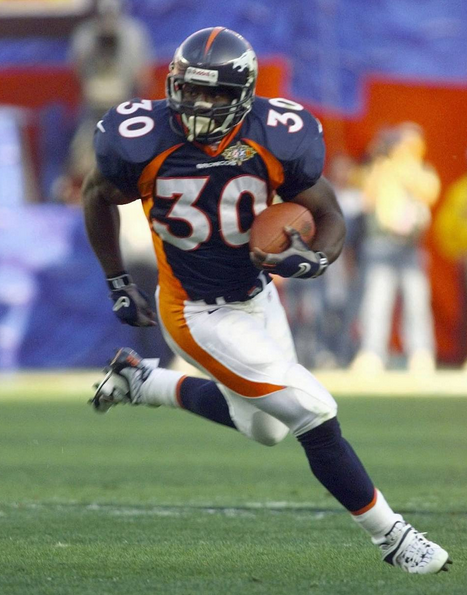When Terrell Davis retired from the Broncos 12 years ago, I wrote a column saying that, abbreviated career or not, he absolutely belonged in the Hall of Fame. Nothing that’s happened since has changed my mind one iota. If anything, I’m even more convinced Davis is Canton quality, a rare running back who simply caught a bad break — much as Gale Sayers did three decades earlier.
Saturday we’ll find out if the selection committee agrees with me. Davis is a finalist for the first time, and he has the usual formidable competition. Here’s my case for him, then and now:
“I have mixed feelings [about retirement]. It’s tough. My mind tells me one thing, my knees say something else. I know I still have a lot of football in me. But I know that my body is not going to allow me to perform at the level I want to play.”
— Terrell Davis, August 2002
In the late ’90s, Terrell Davis was as good a story as there was in the NFL. Here was an all-pro running back who played blocking back and nose tackle in high school. Who was told “basically my whole college career [at Georgia] that I was no good,” he once said. Who was a sixth-round afterthought in the ’95 draft, taken between Dino Philyaw and Craig Whelihan.
Then he magically rushed for 2,000 yards in a season and led the Denver Broncos, perennial Super Bowl patsies, to two championships. If it could happen to him, it could happen to anyone, right?
But now, almost as suddenly as he appeared, Davis is gone — retired at 29 because of bad knees. Yes, there are limits to medical science, as Mr. Chunky Soup has reminded us. Even with the miracle of arthroscopy, not every torn ligament heals as good as new. Terrell spent the last three seasons trying to recapture his old form, but one injury just seemed to lead to another.
The other night he gave his final Mile High Salute in Denver, and already the debate has begun about whether he merits residency in Canton. The easy answer is: No, Davis simply didn’t play long enough. Four stellar seasons — followed by three crippled ones — do not a Hall of Fame career make. And it’s a persuasive argument. Football, after all, is a battle of attrition, and durability is held in the highest regard. A guy I know at the Hall says the first question old-timers ask one another at get-togethers is: “How long did you play?”
Redskins icon Larry Brown has been kept out of Canton for the same ostensible reason. Terrific as he was at his peak, he lasted just eight years in the league, rushing for a modest — by today’s standards — 5,875 yards. Quite a few fine running backs, in fact, have had their careers cut short by injury or accumulated wear and tear: Gale Sayers, Earl Campbell, Chuck Foreman, Billy Sims, William Andrews, John Brockington. It’s a depressingly long list, especially since only Sayers and Campbell have been elected to the Hall.
You’d be hard-pressed to find another position in any sport that has been so ravaged by injury. Running backs in recent times have become the stunt men of pro football. Put the ball in their belly — or sling them a swing pass — and watch them leap linebackers in a single bound. Or try to. Everybody in the pro game gets beat up, sure, but does anybody take more of a pounding than running backs?
I was just glancing at a list of the NFL’s leading rushers in 2000. Are you ready for this? Six of the top seven didn’t even break 1,000 yards last season [2001]. Edgerrin James blew out his knee. Robert Smith retired. Eddie George, slowed by a painful toe injury, slipped from 1,509 to 939. Mike Anderson wound up splitting time with Davis and Olandis Gary. Fred Taylor got hurt. And Jamal Lewis went down in training camp and missed the entire year.
What other position has that kind of volatility? What other position, for that matter, has had two Pro Bowl players in the past few years — Smith and Barry Sanders — call it quits while still in their primes? The prevailing philosophy among coaches seems to be: give running backs the ball until they drop. Davis carried 481 and 470 times in the Broncos’ two Super Bowl-winning years (postseason included), two of the three highest totals in NFL history. George had 485 touches (428 carries, 57 receptions) in ’99 when Tennessee went to the Super Bowl (again, counting the postseason). Heck, coal miners are treated better than that.
So maybe we need to start looking at running backs a little differently than we do other players. Maybe we need to put more emphasis on how well they played and less on how long they endured. Particularly when you have backs like Davis rushing for 2,008 yards — and then suffering a career-altering injury. Or Jamal Anderson rushing for 1,846 — and doing likewise. Or Garrison Hearst rushing for 1,570 — and missing the next two years. This sort of thing is happening all the time to running backs nowadays, and it would be a shame if Hall voters didn’t begin to take it into account.
That’s not to say Davis should be admitted in his first year of eligibility, just that he’s deserving of the honor somewhere down the line. The yardstick for me isn’t Sayers, a human highlight reel in his brief time in the league, it’s John Henry Johnson. Johnson, whose career ended around the same time as Gale’s, rushed for 6,803 yards and 48 touchdowns over 13 seasons. Davis rushed for 6,413 yards and 56 TDs in his first four years. And you’re going to put John Henry in the Hall but not Terrell?
Explain that one to me.
From The Washington Times, Aug. 22, 2002
Source: pro-football-reference.com

